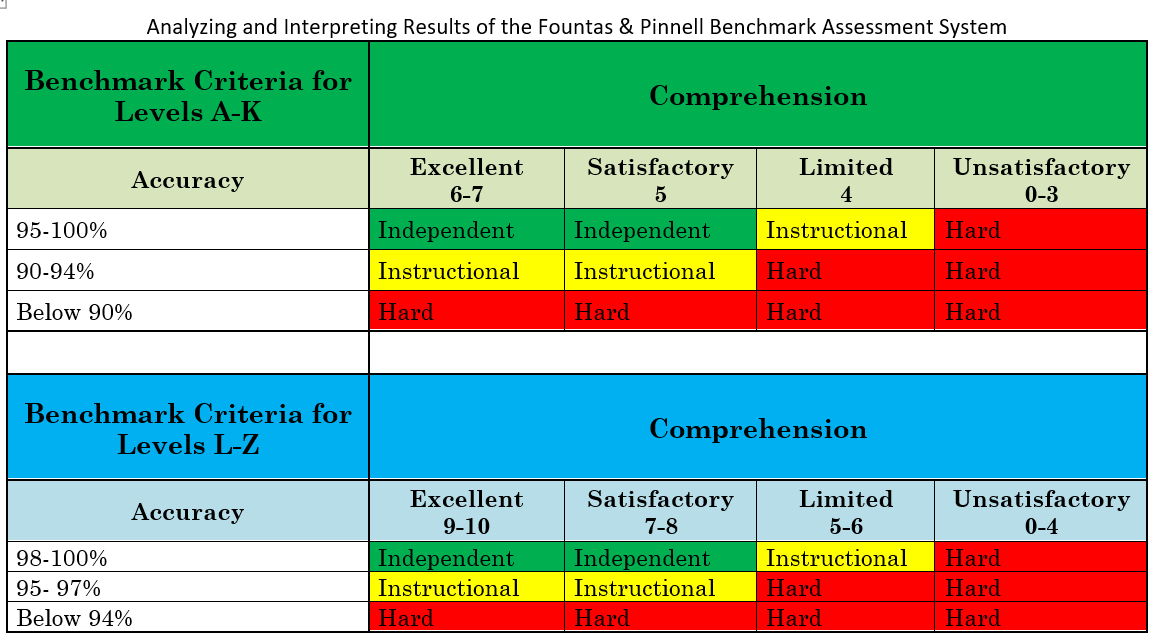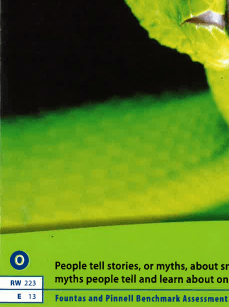How do you code accurate reading behaviors?
Either place a tick above the word or leave it blank.
A child omits a word but the sentence still makes sense. Is this considered correct reading, an error, or a repetition?
An error
What are the categories of comprehension questions?
Thinking within the text
Thinking beyond the text
Thinking about the text
Your student has read 93% of the level I text correctly and has scored 5 out of 7 (satisfactory) on the comprehension portion of the assessment.
Is this text an independent, instructional or hard level text?
 Instructional
Instructional
How many benchmarking kits are there in the Fountas & Pinnell Reading Benchmark Assessment System?
What levels do each kit cover?
2 kits
Assessment System 1: levels A-N.
Assessment System 2: levels L-Z.
When a child substitutes an incorrect word for what is in the text, how do you code it?
Write the child's exact response above the typed word.
What does M S V stand for?
Meaning, Structure, Visual
What is the first thing the teacher must do when opening up the comprehension conversation?
Read the open ended prompt that is above the question prompts, which usually says, "Tell me what you learned" or "Tell me about the story."
You have found that level K is independent for John and level L is instructional.
What now?
Assess John at level M and keep going until you have found his hard level.
What does the black box mean in the benchmark book?
This is where the student stops reading out loud and then reads on his/her own. The words up to the black box are used to determine the accuracy percentage.
Kayden repeats a word correctly 4 times. How do you code this?
Above the word and to the right, write R and a small number 3 near the bottom of the R.
The text has the following sentence:
I went to ballet class on Saturday.
The student reads it as follows:
I went to dance class on Saturday.
What source of information is the child using when making the error?
Meaning
Is the child allowed to go back and look in the text in order to assist with answering a comprehension prompt?
Yes, but only if he/she initiates looking back. We are not to tell him/her that he/she can look back in the text.
On the reading record portion of the benchmark assessment, a child's accuracy is 90% on a level M text. What does the teacher do now?
1. Politely stop assessing the student on this level. (Do NOT administer the comprehension conversation portion of the assessment.)
2. Note this text as being hard on the summary sheet
3. Either move down to the next level (if you have not yet found his/her highest instructional level) or celebrate🎉that you have finished assessing this student for you have found his/her highest independent and highest instruction levels as well. 😊
A child benchmarks "out" of the assessment system at level Z (Z is independent for her) in Primary 4 (third grade). What now?
You no longer have to benchmark her and place her in a group with other high flyer readers.
RESEARCH THIS MORE AND FIX
How do you code the following behavior:
Stacee self corrects a word in the middle of a sentence after she rereads the entire sentence.
Code the repetition (draw a line with an arrow from the R at the end of the sentence to the beginning).
Code SC next to the substitution, being sure to draw a connecting line from the repetition line to SC.
The sentence in the text reads as follows:
He was excited about the basketball tournament.
The child reads:
He was exited about the basketball tournament.
He then rereads the sentence correctly.
What source of information was he using when he made the error? What source of information was he using when he self corrected?
Error: Visual
Self correction: Meaning
Unprompted, a child reveals that she understands how the main character changed in the story.
Later on, there is a prompt that asks about how the main character changed. What do you do?
You skip over the prompt but give the student credit for understanding this key concept.
Keisha is independent at level B but level C is hard for her. What now?
B is considered her instructional level for data and instructional purposes. Instruct Keisha at level B but expect her to move quickly to a placement level of level C with regular guided reading.
Where do you find the number of errors that determines when a text is hard?


What do you do and how do you code when a child says a word incorrectly and then asks you if it is right?
First you write the letter A (appeal) to the right (next to the substitution).
You can then either give a "Told" if you think the child is not able to self correct on their own. This is coded by writing a T below the line, to the right of the word.
Or you can respond by saying, "You try it." Then write the letter Y below the line and to the right of the A. This can also be followed with a Told if the child does not respond after 3-5 seconds or reads the word incorrectly again.
What is the formula for calculating the self-correction ratio and why is it important to know this data?
errors + self-corrections/ self-corrections
It lets us know how often students are noticing when they have made an error; it also reveals if they are attending to the text; the SC ratio informs instruction.
There are only two questions in the "Thinking Beyond the Text" portion of the comprehension conversation, yet the student can score up to 3 points in this section.
What does this tell you about scoring each comprehension section?
One question is not equivalent to one point.
Instead, teachers are to score each section wholistically, utilizing the comprehension rubric descriptors.
The benchmark results are uneven. Lisa is independent at level G. She is instructional at level H and then level I is independent . You then find J is hard for her.
The numbers don't line up! What do you do?
Level I is where you place her for instruction and report it as her instructional level for data purposes.
At what levels does the teacher tell the student to point to the words as he/she reads?
Levels A & B